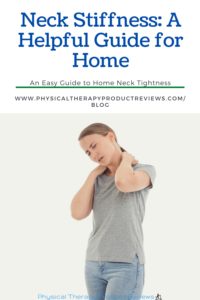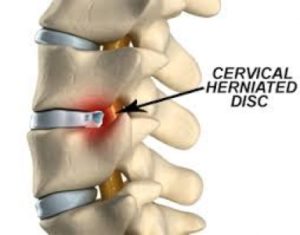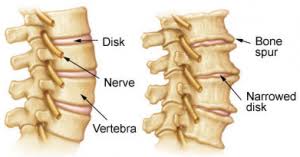Neck Pain and Stiffness
 Neck pain, for the most part, is a very common condition that almost everyone experiences at some point – this is usually a result of tense muscles or sleeping in an awkward position overnight. Some studies estimate a 1-year incidence of neck pain to be between 10.4 – 21.3%, with higher incidence rates in office and computer workers.1 Fortunately, most cases will spontaneously resolve themselves within a few weeks. However, if the symptoms persist for longer than a few months, the pain has become chronic and may suggest a more serious problem. It is worthwhile to understand some of the causes of neck pain and when/how to begin treating your symptoms.
Neck pain, for the most part, is a very common condition that almost everyone experiences at some point – this is usually a result of tense muscles or sleeping in an awkward position overnight. Some studies estimate a 1-year incidence of neck pain to be between 10.4 – 21.3%, with higher incidence rates in office and computer workers.1 Fortunately, most cases will spontaneously resolve themselves within a few weeks. However, if the symptoms persist for longer than a few months, the pain has become chronic and may suggest a more serious problem. It is worthwhile to understand some of the causes of neck pain and when/how to begin treating your symptoms.
Causes of Neck Stiffness
Strained Muscles
With technology and electronics becoming an increasingly important part of our days – both at work and at home – the muscles of the neck and shoulders are placed under even more stress than usual. For example, long periods of time sitting at a desk with slightly tensed muscles can contribute to pain and stiffness in the neck.2 Even if you did not sit at a desk for work, other activities such as painting (requiring you to look upwards at a ceiling at times) or even athletics (ex. racing a bike while looking downwards) can create or intensify neck problems.2
Disc Injury
 The spine is broken down into three major sections – the cervical, thoracic, and lumbar spine.3 Each section consists of bony structures, called vertebrae, which lay on top of one another, with fibrous discs in between.3 The cervical spine is the uppermost portion of the spine and is made of 7 cervical vertebrae, which are located at the base of the skull where our neck is located.3 Sometimes this hollow canal created by the vertebrae is too narrow and the spinal disc tissue can bulge or “leak out,” putting pressure on the spinal nerve.2 This may also be caused by traumatic events, such as whiplash or collision injuries.2
The spine is broken down into three major sections – the cervical, thoracic, and lumbar spine.3 Each section consists of bony structures, called vertebrae, which lay on top of one another, with fibrous discs in between.3 The cervical spine is the uppermost portion of the spine and is made of 7 cervical vertebrae, which are located at the base of the skull where our neck is located.3 Sometimes this hollow canal created by the vertebrae is too narrow and the spinal disc tissue can bulge or “leak out,” putting pressure on the spinal nerve.2 This may also be caused by traumatic events, such as whiplash or collision injuries.2
Arthritis (Spondylosis)
We all age, and with the normal aging process comes associated degeneration of our bodies.4 As with other parts of the body, normal signs of wear and tear can arise within and around the spine, causing acute or chronic pain, especially near the neck.4 The degeneration usually manifests itself as a flattening of the fibrous discs sandwiched between vertebrae. They lose their disc height, and the joints between vertebrae can become “rusty,” leading to something called cervical spondylosis.2 It is this degeneration cascade that contributes to changes that can cause compression, pain, and lack of mobility in the neck.4 
Tips for Neck Stiffness
Neck tightness/stiffness can manifest at any time. If you begin to experience this kind of sensation in your neck, consider the tips below to help improve the immediate discomfort:
Keep Active
Though neck pain can become quite debilitating, it is important to maintain regular activity throughout your day. Staying active may not directly impact your neck pain, but it can improve your overall state of health.5 Some evidence has suggested that upper body (neck, arms, and shoulder) strength training can potentially improve neck pain immediately after treatment and in the short term follow up, but one should be careful not to over-stress the neck muscles and cause even more damage.6 Most importantly, higher levels of physical activity, even low-impact activities like walking and gentle stretching, can contribute to general healthy lifestyle behaviors and have been shown to be associated with less neck and shoulder pain.7
Apply Heat
In recent years, studies have suggested that thermotherapy (the therapeutic use of heat/hot temperatures) be most effective in healing injuries and muscle soreness when compared to cryotherapy (the therapeutic use of cooling/freezing temperatures).8,9 Applying heat to areas of muscle tightness, such as your neck, increases blood flow to the region and improves tissue “stretchability.”8 Thus, using mild heat on the neck/shoulders can help to loosen tight neck muscles and improve mobility. We recommend a hands-free heating wrap for your neck, so you can relax your neck muscles without constantly needing to hold a heating pack to the region!
Try a Pillow Designed for Neck Pain
Oftentimes neck pain is caused by the uncomfortable position in which we sleep, which can force our neck out of proper alignment, further exacerbating the problem. Because sleep in itself is a critical aspect of any injury/pain recovery, you want to be sure that you are using your time asleep to relax your muscles, rather than further straining them. Cervical pillows are designed to keep your neck properly aligned while you sleep.10 By preventing unnatural curvature of the neck while sleeping, these pillows allow you to maintain the normal cervical curve and improve your posture.10 A great option that we love is a memory foam orthopedic sleeping pillow, which is designed specifically to contour your head and neck and provide pain relief.
Use a Home Traction Unit
Cervical tractions units, though once a rare and expensive commodity, have recently become a popular and cheaper treatment option for those suffering from neck pain. Generally, a home traction device provides constant tension to gently pull your head away from your neck and allow for expansion of the spinal vertebrae and eliminate any compression that could be causing discomfort.11 This is especially helpful in relieving pain caused by bulging discs, pinched nerves, and cervical spondylosis.11 A great option that we recommend is a neck hammock, which hammocks your head and gently stretches the neck.
Try a Topical Analgesic
Topical analgesics are drugs used for painful conditions that can be applied as a topical agent directly on to the skin of the affected region.12 Some analgesics are meant for acute injuries, such as strains and sprains, while others are used for chronic or arthritic pains.12 In the case of acute neck stiffness and/or pain, certain formulations of analgesic medication have been shown to have moderate efficacy in reducing immediate pain without the risk of withdrawal symptoms.12 Although analgesics are not a long term solution, they can be helpful in alleviating pain for long enough to undergo more extensive treatments to solve the underlying problem of your neck pain. One product we love is the Penetrex pain relief formulation to help reduce inflammation and tightness.
Do you need a neck traction unit for the home? See our reviews of the best Home Cervical Traction unit here.
Exercises to Fix a Stiff Neck
Stretches for Neck Stiffness
Upper Trap Stretch
Goal: Loosen the muscles of trapezius to relieve neck, shoulder, and upper back pain
Instructions:
- Sitting down, place the arm you want to stretch underneath your seated leg, to hold the shoulder down
- Alternatively, you can consciously extend your arm to hold the shoulder down
- With your free hand, gently tilt your head away from the designated shoulder
- Hold the stretch for several seconds
Levator Scap Stretch
Goal: Stretch the levator scapula muscle of the side neck and improve flexibility
Instructions:
- Begin either sitting or standing up
- Place left arm underneath your chair to pull your shoulder down
- Rotate your head to the right
- Using your right hand, gently pull your head down
- Imagine trying to touch your chin to your right shoulder
- Repeat on the other side
Neck Towel Rotation
Goal: Promote neck rotation to stretch the neck and improve pain
Instructions:
- Use a BJJ belt or a towel draped around your neck
- Hold both ends of the towel with your hands.
- Use your right hand to stabilize/anchor that end of the towel to your body
- With your left hand, bring the other end of the towel to eye level keeping the towel taught
- Slowly turn your head to the right until you begin to feel tightness in the neck
- Make sure your chin stays level and does not lift upwards. Imagine touching your chin to your shoulder
- Once you feel neck stiffness, use the left hand and towel to coax the head to turn even further
- Repeat several pulses, then proceed to stretch the other side of the neck
Neck Towel Traction
Goal: Gently stretch the cervical spine to release the tension on pinched nerves or bulging discs
Instructions:
- In a seated position, take a towel and drape it around your neck
- Take both ends of the towel and pull upwards
- the towel should rest at the junction between the back of your head and your neck
- Hold for 15-30 sec
- Maintain tension on the towel and pull upwards and slightly to the right/left
How to Prevent Neck Stiffness From Coming Back
Even better than treating neck pain after it occurs is to prevent the pain from occurring altogether. Below we have outlined some of the exercises that can take a proactive approach to prevent injuries before they occur.
Neck Strengthening Exercises
Prone Chin Retraction
Goal: Improve cervical posture and muscle activation to reduce postural tension and neck discomfort
Instructions:
- Begin by lying face down on the floor/mat
- Rest your forehead on your hands
- Slowly lift your head and shoulder off the ground
- Bring your head up towards the ceiling while still keeping your face towards the floor
- Think of pulling your chin back towards your spine
- Perform several pulses then rest your head back on the floor
- Repeat this set several times
Supine Chin Tuck and Lift
Goal: Strengthen the cervical flexor muscles and stretch the muscles in the neck
Instructions:
- Lie on the ground with your back on the floor
- Feet on the ground with knees bent
- Head facing the ceiling
- Breathe in, then breathe out fully, letting your ribs come down
- Create intra-abdominal pressure 360 degrees around your abdomen when you breathe
- With two fingers, push your chin downwards
- Then lift your head and chin backward
- Move only in the neck
- Chest and upper body should remain stable
- As you bring your chin downwards again, lift your head as well and hold
- Repeat 10-15 times
Don’t Forget About Posture
As we slump over in our desk chairs at work or walk around the neighborhood staring down at our phones, most of us fail to focus on our posture throughout the day. There are two types of posture – dynamic posture (how you hold yourself when you are moving) and static posture (how you hold yourself when you are not moving).13 Both types of posture contribute to injury prevention and long term health. Specifically for neck pain, when we engage in unhealthy posture and make it a habit, we put unnecessary stress on our head and neck. Below are some tips on how to improve both your dynamic and static posture.
How to improve dynamic posture:13
- Stay active in general – exercises like yoga, tai chi, and mind-body awareness are especially helpful. Exercises that strengthen the core will help with proper posture
- Wear comfortable shoes – this seems silly, but high-heeled shoes can disrupt your balance while walking and force you to revert to improper posture habits
- Be mindful – simply, just being aware of you are slouching over your phone while walking or notice that your back is overly arched can be enough to help you correct your form
How to improve static posture:13
- Switch sitting positions often and take movement breaks – ironically, a recommendation for static posture is to implement dynamic movements. Make sure to get up and move around every hour or so
- Don’t cross your legs and make sure your feet touch the floor
- Support your back – chose sitting positions where you will have back support, whether that be a chair back, pillow, or backrest
Conclusion
Though neck pain is very rarely a sign of a serious condition, it is important to recognize the signs when your body is stressed and not functioning properly. Whether your neck pain is due to an awkward night of sleep or constant, poor posture, the most important thing you can do is address these problems as they occur. We hope that the knowledge and recommendations we have detailed above will help you relieve your neck pain.
Works Cited
- Hoy, D.G., Protani, M., De, R., and Buchbinder, R. (2010). The epidemiology of neck pain. Best Practice and Research: Clinical Rheumatology 24, 783–792.
- (2019). Neck pain: Overview (Institute for Quality and Efficiency in Health Care (IQWiG)).
- Anatomy of the Spine | Southern California Orthopedic Institute. Retrieved at https://www.scoi.com/specialties/spine-doctor/anatomy-spine.
- Ferrara, L. (2012). The Biomechanics of Cervical Spondylosis. Advances in Orthopedics 2012.
- Sterling, M., de Zoete, R.M.J., Coppieters, I., and Farrell, S.F. (2019). Best Evidence Rehabilitation for Chronic Pain Part 4: Neck Pain. Journal of Clinical Medicine 8, 1219.
- McCaskey, M.A., Schuster-Amft, C., Wirth, B., Suica, Z., and De Bruin, E.D. (2014). Effects of proprioceptive exercises on pain and function in chronic neck- and low back pain rehabilitation: A systematic literature review. BMC Musculoskeletal Disorders 15.
- Guddal, M.H., Stensland, S.Ø., Småstuen, M.C., Johnsen, M.B., Zwart, J.A., and Storheim, K. (2017). Physical Activity Level and Sport Participation in Relation to Musculoskeletal Pain in a Population-Based Study of Adolescents: The Young-HUNT Study. Orthopaedic Journal of Sports Medicine 5.
- Nadler, S.F., Weingand, K., and Kruse, R.J. (2004). The physiologic basis and clinical applications of cryotherapy and thermotherapy for the pain practitioner. Pain Physician 7, 395–399.
- Galbraith, R.M., and Lavallee, M.E. (2009). Medial tibial stress syndrome: Conservative treatment options. Current Reviews in Musculoskeletal Medicine 2, 127–133.
- (2017). Sleeping with a Cervical Pillow for Neck Pain — The Brain & Spine Institute of North Houston. Retrieved at https://www.fayazneurosurgery.com/blog/sleeping-with-a-cervical-pillow.
- (2018). What Are The Benefits of Cervical Traction? Plus Exercises to Try. Retrieved at https://www.healthline.com/health/cervical-traction#takeaway.
- Derry, S., Wiffen, P.J., Kalso, E.A., Bell, R.F., Aldington, D., Phillips, T., Gaskell, H., and Moore, R.A. (2017). Topical analgesics for acute and chronic pain in adults – an overview of Cochrane Reviews. Cochrane Database of Systematic Reviews 2017.
Guide to Good Posture: MedlinePlus. Retrieved at https://medlineplus.gov/guidetogoodposture.html.
Disclaimer: The information provided in this post is for educational purposes only. This is not a substitute for a medical appointment. Please refer to your physician before starting any exercise program.





